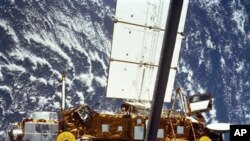At this very moment, the U.S. Department of Defense's Joint Space Operations Center is tracking thousands of pieces of space junk orbiting our Earth. But, even as the Upper Atmosphere Research Satellite known as UARS comes hurtling back toward our planet, experts say it is hard to determine just when or where it will reenter the atmosphere.
Both the Department of Defense and NASA say it is nearly impossible to precisely predict where and when free-falling space debris will reenter the atmosphere, let alone strike or splash down on the planet.
Major Michael Duncan is the deputy chief of space situational awareness at the Defense Department's Joint Space Operations Center, known as JSpOC. He says radars, telescopes and even assets in space provide positional data for orbital debris. A team strings those data points together to create orbits.
"And with the right software you can take an orbit and from where it is right now you can predict where it will be, you know, one, two, three hours from now," Duncan said.
He said a five-member team at JSpOC works 24 hours a day, seven days a week, collecting updates from around the world.
"We take in about 450,000 observations per day, and that helps us track the 22,000 space objects that we track currentl," he said.
Major Duncan said UARS is easy to track because it is about the size of a school bus. But even with all the data points, high-tech software, and the team's accurate predictions, there are multiple variables that can have an effect on when and where debris will reenter.
For instance, Duncan said, it is impossible to determine the way the debris will react once it reaches the atmosphere.
Like a stone skipping across a lake, space junk can bounce across the upper atmosphere. And, Duncan said, even JSpOC's reentry predictions come with a window of plus or minus 15 minutes.
"But even that plus-or-minus 15 minutes can be a track of 5,000 miles difference," he said.
Most of UARS is expected to disintegrate as it reenters Earth's atmosphere.
Mark Matney, an orbital debris scientist at NASA's Johnson Space Center in Texas, says a craft's orientation can even have an effect on how fast it decays.
"It's basically an inert object, and so it can be tumbling. Let's just say it's tumbling in such a way that it presents a large area or small area, it could speed up the rate at which it decays or slows it down," he said.
Matney says solar activity is another variable.
"Sometimes the energy from the sun goes up a little bit and causes the atmosphere to heat up and actually expand, and when that happens, it can accelerate the decay rate of the satellite. If the solar activity were to go down, it would actually cause the atmosphere to cool and contract, and so the spacecraft would not encounter quite as much atmosphere and would slow down its decay," he said.
Major Duncan at JSpOC notes there was a solar storm last week that immediately changed the satellite's anticipated reentry by three days.
UARS was launched 20 years ago and decommissioned in 2005. Matney says times and technologies have changed since 1991.
"Unfortunately, because UARS is an older satellite, it was not designed with the capability to do a targeted reentry, and we've done that before. The Compton Gamma Ray Observatory is a good example where we actually were able to target its reentry over the Pacific Ocean, out in the middle of the ocean where it wouldn't hurt anybody," Matney said.
Still, NASA says the likelihood of UARS hurting anyone is slim. The U.S. space agency says it has no confirmed reports of a person ever being injured or property being significantly damaged by falling debris.
And, given that more than two-thirds of the planet is covered by water, it is likely that UARS will land with a splash and not a thud.
Vague Predictions as Satellite Falls to Earth









